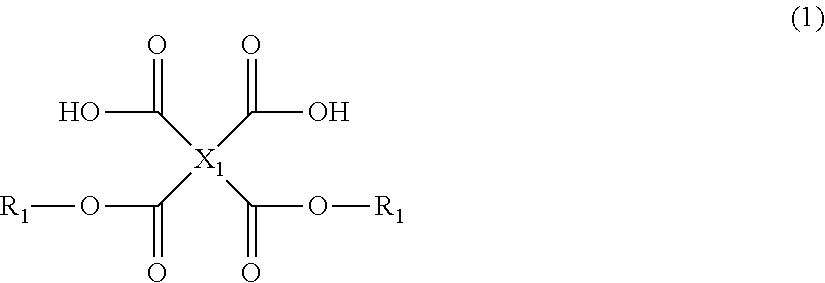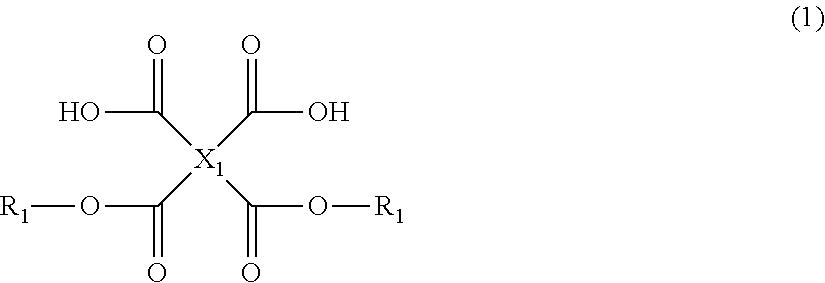Tetracarboxylic acid diester compound, polyimide precursor polymer and method for producing the same, negative photosensitive resin composition, positive photosensitive resin composition, patterning process, and method for forming cured film
- Summary
- Abstract
- Description
- Claims
- Application Information
AI Technical Summary
Benefits of technology
Problems solved by technology
Method used
Image
Examples
examples
[0279]Hereinafter, the present invention will be specifically described with reference to synthesis examples, comparative synthesis examples, examples, and comparative examples, but the present invention is not limited to the following examples.
I. Synthesis of Polyimide Precursor Polymer Having Hexafluoroisopropanol Group
[0280]Chemical structural formulae of compounds used in the following synthesis examples are shown below.
[Synthesis Example 1] Synthesis of Tetracarboxylic Acid Diester Compound
[0281]A 3 L flask equipped with a stirrer and a thermometer was charged with 100 g (322 mmol) of 3,3′,4,4′-oxydiphthalic dianhydride (s-ODPA), 127.6 g (644 mmol) of a compound having a hexafluoroisopropanol, group (HF-1), and 400 g of γ-butyrolactone. To this solution was added 2.5 g (16 mmol) of 1,8-diazabicycloundecene under stirring at room temperature, and the solution was further stirred at room temperature for 24 hours. Then, 5.8 g of 10% hydrochloric acid aqueous solution was added dro...
synthesis example 2
[Synthesis Example 2] Synthesis of Polyimide Precursor Polymer (A-1)
[0284]In a similar manner, a 3 L flask equipped with a stirrer and a thermometer was charged with 100 g (322 mmol) of 3,3′,4,4′-oxydiphthalic dianhydride (s-ODPA), 127.6 g (644 mmol) of a compound having a hexafluoroisopropanol group (IF-1), and 400 g of γ-butyrolactone. To this solution was added 2.5 g (16 mmol) of 1,8-diazabicycloundecene under stirring at room temperature, and the solution was further stirred at room temperature for 24 hours. Then, 78.5 g (660 mmol) of thionyl chloride was added dropwise to the resulting solution under ice-cooling while maintaining the reaction solution temperature at 10° C. or less. After dropwise addition, the solution was stirred for 2 hours under ice-cooling. Then, a solution in which 58 g (290 mmol) of 4,4′-diaminodiphenyl ether (ODA), 1.8 g (16 mol) of 4-aminophenol (AP), and 104.4 g (1,320 mmol) of pyridine have been dissolved in 239 g of γ-butyrolactone was added dropwise...
synthesis example 3
[Synthesis Example 3] Synthesis of Polyimide Precursor Polymer (A-2)
[0286]The following polyimide precursor polymer (A-2) was obtained in the same manner as in Synthesis Example 2 except that 3,3′,4,4′-oxydiphthalic dianhydride (s-ODPA) was changed to 100 g (322 mol) of 2,3,3′,4′-oxydiphthalic dianhydride (a-ODPA). When the molecular weight of this polymer was measured by GPC, the weight average molecular weight was 16,200 in terms of polystyrene.
[0287]In the obtained polymer (A-2), the introduction amount of the hexafluoroisopropanol group was 0.23 mol with respect to 1.00 g of the polymer.
PUM
| Property | Measurement | Unit |
|---|---|---|
| Temperature | aaaaa | aaaaa |
| Nanoscale particle size | aaaaa | aaaaa |
| Nanoscale particle size | aaaaa | aaaaa |
Abstract
Description
Claims
Application Information
 Login to View More
Login to View More - R&D
- Intellectual Property
- Life Sciences
- Materials
- Tech Scout
- Unparalleled Data Quality
- Higher Quality Content
- 60% Fewer Hallucinations
Browse by: Latest US Patents, China's latest patents, Technical Efficacy Thesaurus, Application Domain, Technology Topic, Popular Technical Reports.
© 2025 PatSnap. All rights reserved.Legal|Privacy policy|Modern Slavery Act Transparency Statement|Sitemap|About US| Contact US: help@patsnap.com



